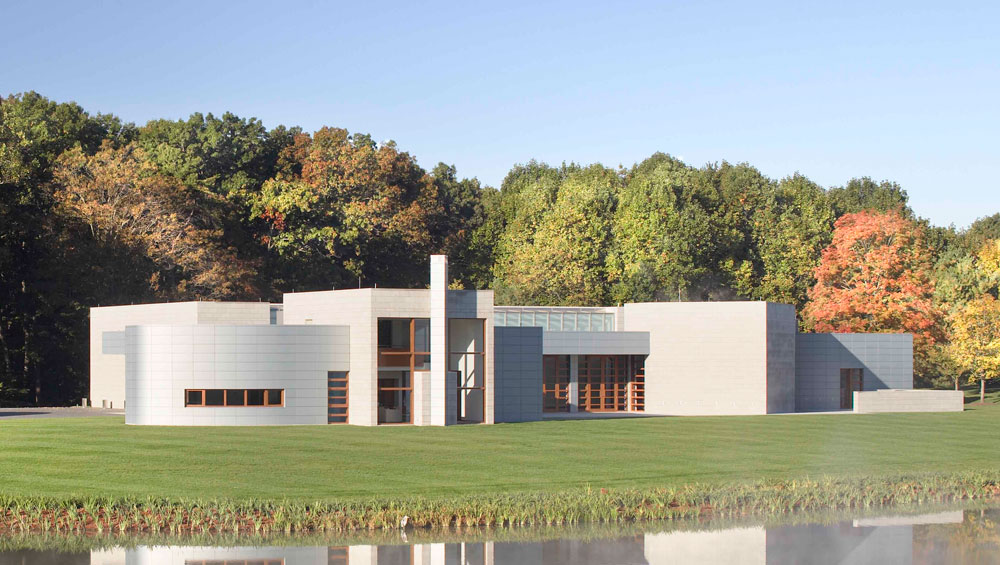
The Gallery. Photo: Scott Frances. Courtesy: Glenstone Museum.
by JILL SPALDING
At the time of my first encounter with Glenstone, in 2011, the 30,000 sq ft space, built by the industrialist fortune of Mitchell P Rales and curated by Emily Wei – now Wei Rales – still stood on its own. No longer fledgling, it had been reaching out under the radar since 2006 to an edited public with sophisticated exhibitions that had brought it art-world recognition as a museum of vision over vanity. Intensely private, almost reclusive, the Charles Gwathmey-designed building nestled into 100 acres of an old hunting estate in Potomac, Maryland, 14 miles from Washington DC and an easy stroll from the Raleses’ home. The surrounding grounds had been thoughtfully landscaped and planted to block out the nine-and-counting McMansions that had not been already purchased for demolition to create more open vistas.
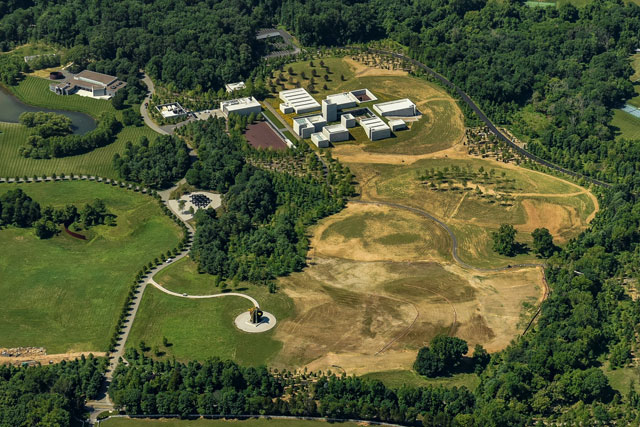
Aerial view of the Pavilions and the Gallery. Courtesy: Glenstone Museum.
Word was out of a planned expansion and, although details remained vague, the Raleses were known to be collecting aggressively in anticipation of more space and diversity. Driving their passion was an aesthetic and a mission, both initially forged from Mitchell Rales’s years of conversation with modern art and a helicopter crash that had left him with only his passport and a vision that now, with Emily on board, was tacking tougher, braver, closer to concept, and focused on talent that radiated urgency.
Capital A art, without qualification, is the Raleses’ first love and the museum’s raison d’etre. Theirs was already a formidable collection – think modern and contemporary art masters from Matisse to Christopher Wool via Willem de Kooning, Franz Kline, Andy Warhol and Mark Rothko – curated with painstaking exactitude and a resolve to “get it right”. Committed to collecting only what they loved, the Raleses de-accessioned only to trade for a work they had tracked and were tenaciously waiting for. “A Pollock for a Johns” was proffered as an example, indicating that their collection was building on living artists, not dead ones – for the opportunity, it would seem, of collaborative interaction. (Ellsworth Kelly, Cy Twombly, David Weiss and On Kawara were not only living when their works were commissioned, but had been closely involved in their placement.)
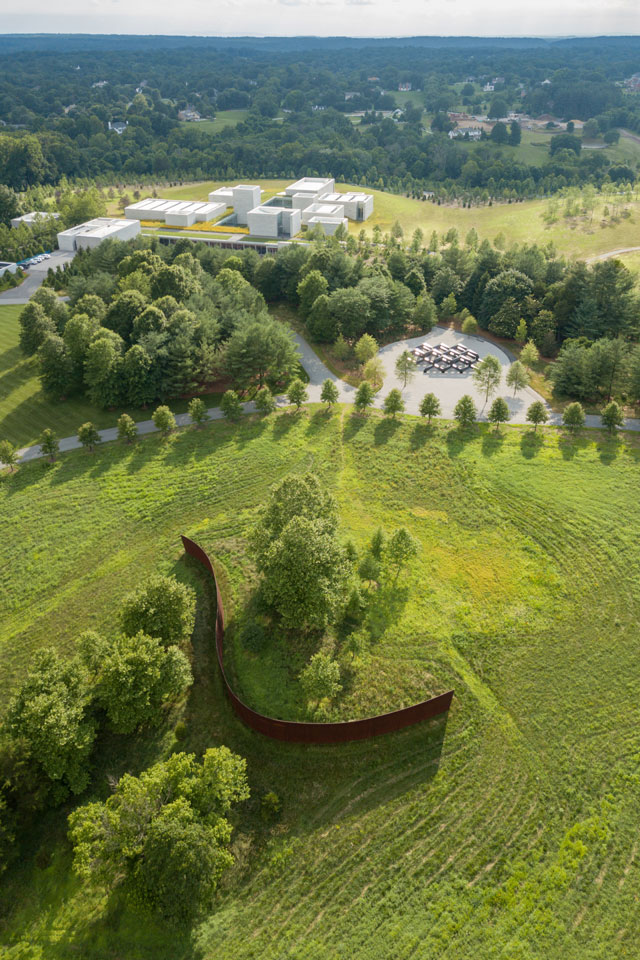
The Pavilions with Richard Serra’s Contour 290, 2004, and Tony Smith’s Smug, 1973/2005. Photo: Iwan Baan. Courtesy: Glenstone Museum.
Touring with a small group on that first visit, I was led through the front door as into a sanctorum. The standard greeting – “You are welcome to view this part of the exhibition and continue on to the next building, then you’re on your own” – was obviated by Emily Rales, who rounded the corner, notebook in hand, with an offer to walk us through the featured exhibition. By way of a memorial to Weiss, this retrospective of his storied collaboration with Peter Fischli fully illustrated what she called repeatedly, like a mantra, “the Glenstone way”. (As formally stated, the “Glenstone way” is to wait 15 years before committing to an artist; to research and collect the artist in depth; to give each work maximum exposure, exhibit it for two years, let it travel to other museums and, every 10th year, show it again.)
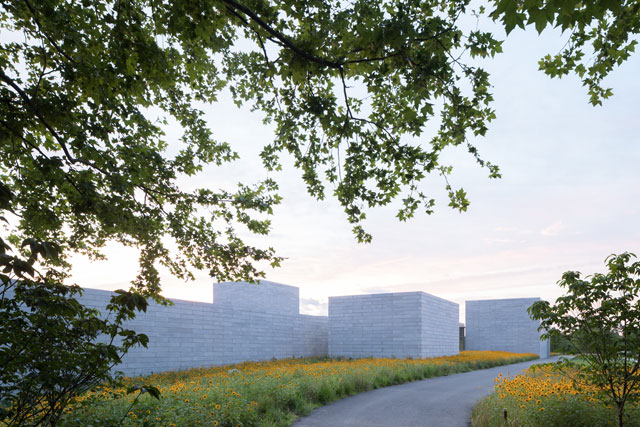
Approach to the Pavilions. Photo: Iwan Baan. Courtesy: Glenstone Museum.
Viewing an exhibition with its curator can be intimidating. Emily Rales is exceptional in that her involvement with the art is emotional. “Captivated” was the word she offered for her initial encounter with each work, and her continuing delight in them all was infectious. Despite her impressive art-world credentials (stints at the Guggenheim Museum and the Marlborough Gallery, director of the Barbara Gladstone Gallery, head of a non-profit movable feast of pop-up exhibitions, and now her “day job” curating their collection), she distrusts the artspeak jargon that “spouts back what you’ve read”, preferring wall texts to serve as simple identifiers that let the art speak for itself.
The Fischli-Weiss show was especially revealing: a tour-de-force installation comprising hundreds of polyurethane components that took up a whole room, it presented as at once accessible and highbrow, quotidian and metaphysical, mirthful and melancholy – a witty and wry take of thoughtful artists on art-making. (In her forward to the catalogue, a mission statement of sorts, Rales describes how, on first encounter with the work at a Tate retrospective, she and her husband were “awed and charmed by its elaborately conceived approach to art about art”.) Telling, too, how she would choose to exhibit the late, bare-thread minimalist Fred Sandback. Initially, she had wanted to pair him with another artist but, thinking over how best to organise the space, instead removed a few walls to enable a razor’s edge dialogue between Sandback and Gwathmey.
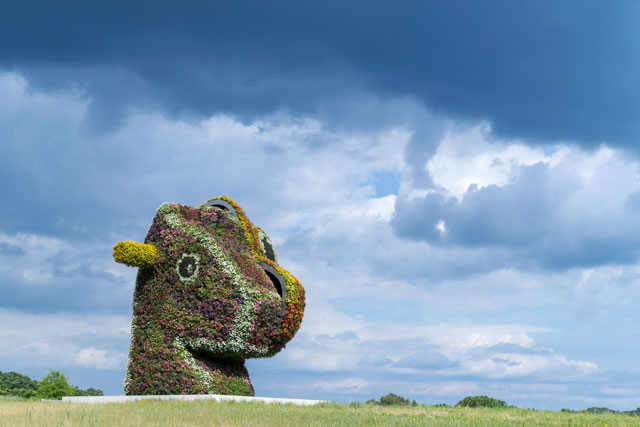
Jeff Koons’ Split-Rocker, 2000, is the first outdoor sculpture visitors see at Glenstone Museum. Photo: Iwan Baan. Courtesy: Glenstone Museum.
Led outside after lunch, we communed with exuberant riffs on the seasons provided by four works the contemporary art world holds iconic; the high-maintenance floral effulgence of Jeff Koons’s Split-Rocker (2000), Charles Ray’s mock-harvest Untitled (Tractor) (2008), Richard Serra’s autumn-red conical Corten-steel Sylvester (2001) and, reaching out to them all, the long shadow of Ellsworth Kelly’s wintry (Untitled) totem. Gwathmey’s Glenstone “phase one” itself presented as a sculpture, a modernist grey geometry of sleek, angled limestone softened by interventions of long picture windows (one stretching to 37ft) that view on acres of designated grassland.
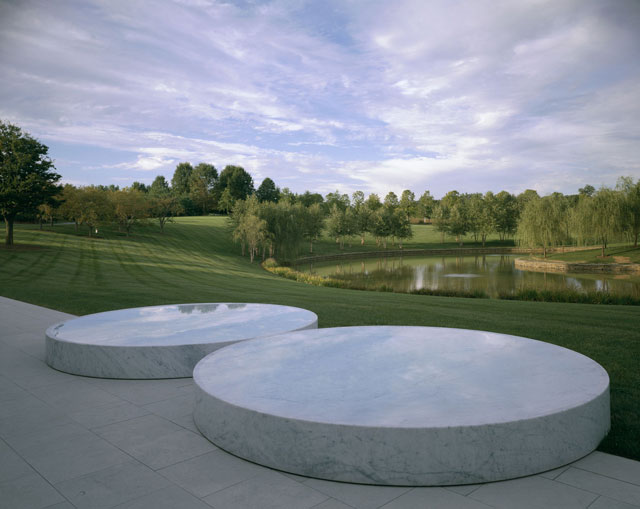
Felix Gonzalez-Torres, Untitled, 1992-1995. © The Felix Gonzalez-Torres Foundation. Photo: Jerry L. Thompson. Courtesy: Glenstone Museum.
Detailed with field-marshal precision in the notebook tucked under her arm were Emily Rales’s plans for “phase two”. A call away from her mobile phone was the team of outside and inhouse experts and associates, curators and technicians, landscapers and installers, without whom this immense collaboration would not materialise. Like a latterday Prospero, Emily Wei Rales waved a wand over her incipient paradise. To the north, earth was being excavated and materials hauled in for The Pavilions – 11 interlocked galleries designed to provide six and a half times more exhibition space. The overall project was overarching in scope and audacious in concept – a private museum with the gravitas of the Frick and the scale of the Getty Villa in Los Angeles. To fill it, the Raleses would increase their holdings to 1,300 works, all while retaining an absolute commitment to quality: (Emily Rales has said that if they can no longer obtain an artist’s top work – she singled out Barnett Newman – “We won’t even go there”.) Waiting with inexhaustible patience for only the best, they were quietly amassing deep holdings of such as David Hammons, Eva Hesse, Vija Celmins and Louise Bourgeois, all of whom, like the nine artists given dedicated pavilions were selected for their uncompromising vision and unique contribution to creative expression.
Seven years on, advance word – from National Gallery director Earl Powell’s “impressive and elegant” to Larry Gagosian’s “unprecedented in scale” – has been ecstatic. Inevitably, perhaps, the press were less certain, conflating Glenstone’s purpose with that of the nation’s current rash of clubby “family” collections and faulting its not-for-profit status as a tax shelter designed to provide write-offs for its upkeep. The art world demurred, recognising from the outset that Mitchell Rales has been motivated by a deep belief in the transformative power of art, has consistently donated top works to major institutions (as with four Baldessaris to the Hirshhorn Museum), and continues with his wife to implement their vision for a world-class viewing experience by building Glenstone’s collection into the best that money can buy. Their vision, on the other hand, is by no means quixotic, given that their three stated rules of purchase specify 1) historically important 2) emotionally compelling and 3) financially sound.
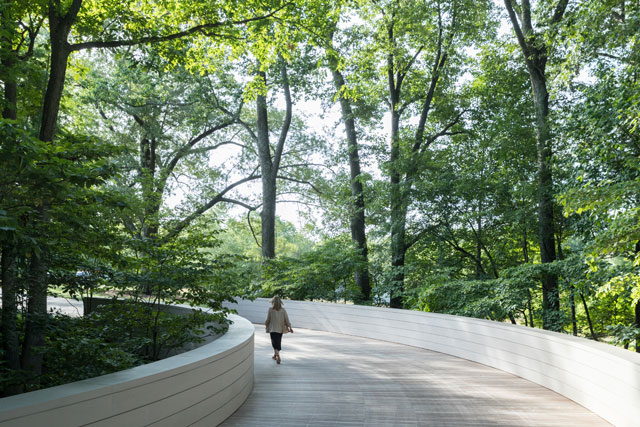
Approach to the Gallery. Photo: Iwan Baan. Courtesy: Glenstone Museum.
As to Glenstone’s future, don’t think playground, like those selfie museums multiplying in China – or social entry, like the rash of eponymous show spaces spreading across the US that are given over to starchitects and stocked with the day’s fashionable sweepings from auctions and art fairs. Fully aware of the enormity of what they have undertaken, the Raleses have planned with the exactitude of a military operation what it will take to sustain 230 landscaped acres, 60-plus staff, facilities that can accommodate 100,000 visitors annually, an ongoing programme of education and a self-sufficient, six-building museum that will remain at once open to public viewing and secure enough to protect priceless art. Testifying to their mission, they also have given a great deal of thought to endowment, a concern that industrial-billionaire wealth will likely assure.
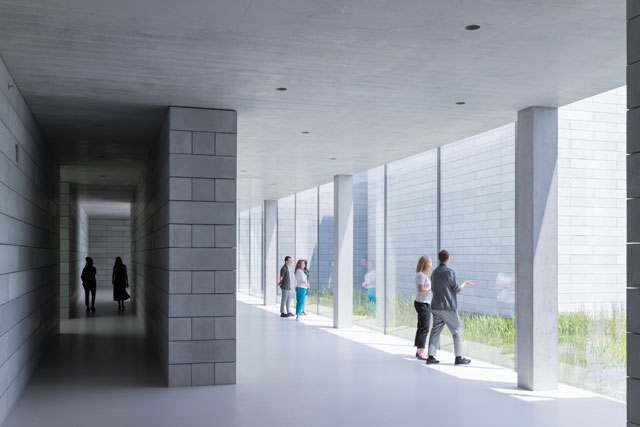
The passage in the Pavilions. Photo: Iwan Baan. Courtesy: Glenstone Museum.
I have addressed the prosaic upfront because Glenstone, as it unfolds now, is pure poetry. Past the gate of 12002 Glen Road, stretches of subtly shaped meadow proffer at once the calm of a Walden Pond communion with nature and the thrill of outdoor sculpture experienced in a habitat all its own. Like that Cracker Jack box, the whole seemed familiar to me, but each element surprised. Drawn from existing modalities, as filtered through the lens of the Raleses’ deep knowledge and groundwork, they add up to a convincingly original scheme.
Nothing lingers of those setbacks that caused successive delays. Even as completion of phase two was deferred, both the landscaping and pavilions had been so closely coordinated as to be realised of a piece at any moment, like a barn-raising. Little, surprisingly, had been leaked of the art; raising expectations to the fizzing point, both guides and guards had remained tight-lipped about what would be unveiled. The only names floated were of the nine artists who would receive a dedicated pavilion; On Kawara, Pipilotti Rist, Charles Ray, Martin Puryear, Brice Marden, Michael Heizer, Robert Gober, Lygia Pape and Cy Twombly.
Better reported was the process. Shattered by the death of Charles Gwathmey, who had been held integral to the second phase, the Raleses had undertaken a search for a successor sympathetic to their programme. “He had to be mid-career, be familiar with permits, and already have built a museum,” said Emily Rales. Under the guidance of the architectural historian Paul Goldberger, they eliminated the too-busy, too-demanding big guns and narrowed their selection to three; Peter Zepponi, Tod Williams/Billie Tsien and Thomas Phifer. Emily Rales laughed at the delicate dance that prefaced their decision to go with Phifer. “We dated him for six months, he brought flashcards of all that he found meaningful and relevant – a Shaker village, a Louis Kahn building, ancient objects, rock gardens”, a pliant and fluid approach that beat out the “hard rubber” competition – and came up with the Kyoto temple-inflected scheme of clustered galleries circling an 18,000 sq ft Water Court.
With architect and footprint in place, the Raleses went into high gear, consulting with a fleet of visiting experts on every component of design and terrain that might enhance or impinge on structure and landscape. Testing materials for sound, compatibility and resilience, they heeded Cy Twombly’s warning against making it “too chic” by exchanging the Pavilions’ planned travertine tile surface for cast-concrete. Addressing mood and atmosphere with unexpected juxtapositions, they planted Charles Ray’s harshly metallic Horse and Rider (2014) into a wildflower field and pitted Tony Smith’s roiling Smug (1973-2005) against the calm of a meditation room. To dazzle the casual visitor benumbed by the single-artist pavilions, they jazzed a larger one with 65 works by 52 artists. To achieve textbook sustainability, they replaced the maple trees that onsite ecologist Peter Walker said “had no business being here” with 8,000 indigenous species, seasonal native plantings and a palette of grasses. To oversee the collection’s conservation and restoration, they worked up state-of-the-art on-site facilities.
Most particularly, they obsessed on the impact of light; the reflections of snow, sun and water; the shadows cast by trees, buildings and outdoor sculpture as the light shifts through the day; variations as maximal as the seasons and as minimal as clouds. Despite computer models that had analysed these conditions down to the minutest refraction, Emily Rales remained “super-worried” about how to best light the art. She was not at all sure that her instinct to replace indoor electricity with strategically placed clerestory natural lighting would prove optimal, because there were still unknown factors. “I think it’s all right that the light will progress with the day, from soft to strong to fading, but there are so many other variables. The reflection off the water could be blinding,” she fretted. “If we don’t get the light right, it won’t work.”
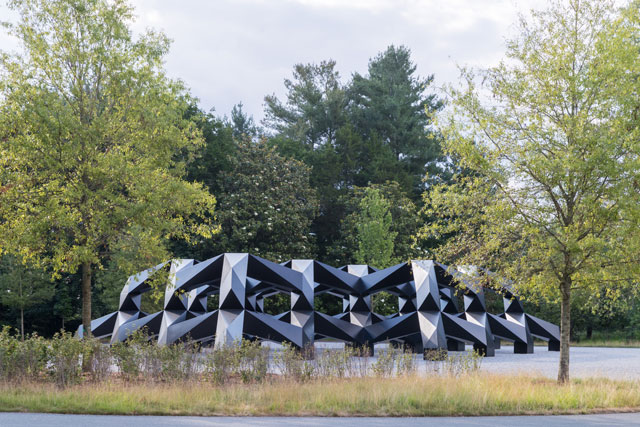
Tony Smith, Smug, 1973/2005. One of the outdoor sculptures installed at
Glenstone Museum. Photo: Iwan Baan. Courtesy: Glenstone Museum.
They did and it does. Posing for the press two weeks before opening day, with every penny of its rumoured $125m (£95m) expansion proudly visible, Glenstone was ready for its closeup.
“Perfection” is the first word off the tongue for the seemingly natural harmony of a built ecosystem edited down to the last blade of grass. “Astounding” a close second as the massive project unfolds an additional 130 acres of designed landscape and a 240,000 sq ft expansion extending to exhibition space, storage facilities, cafes, education centre and arrival hall, a footprint exceeding that of the Whitney Museum, which, if such can be said of a building, is its muse.
The inaugural display features a group hang that sets a clutch of American contemporary art giants (Jasper Johns, Rothko, Jackson Pollock and Ruth Asawa, an early combine by Robert Rauschenberg, paintings by de Kooning, Keith Haring and Sol LeWitt) against the lesser known Japanese artists Kazuo Shiraga and Atsuko Tanaka. There are works by Lawrence Weiner at the entry and by Roni Horn around the Water Court. More focused and formal, the dedicated pavilions slow you down. Strung along a wall, On Kawara’s horizontally linear-date paintings convey an end-of-time certainty. Animated by the light, Marden’s specially commissioned multipanel painting – five years in the making – alters your mood as it shifts with the day.
The outdoor installations are commanding, of a piece in the attention to their placement but to varying effect. “Stirring” the word for Untitled, Felix Gonzalez-Torres’s pair of reflecting pools positioned to cantilever over the void of so short a life. “Unsettling” describes the exploded beams piercing the unfathomable depths of Heizer’s 10-years-in-the-making Collapse (1967/2017) and Compression (1968/2017).
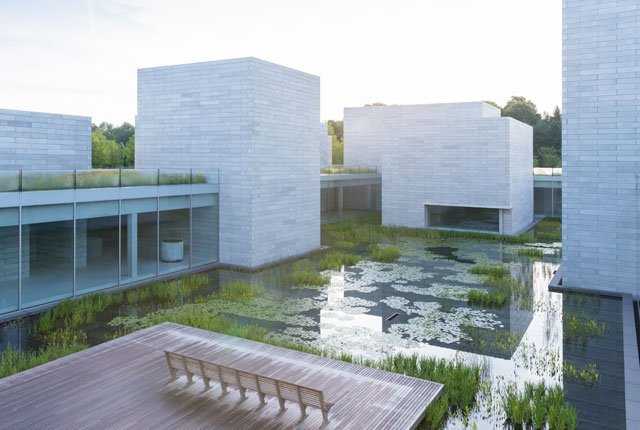
Water Court at the Pavilions, Glenstone Museum. Photo: Iwan Baan. Courtesy: Glenstone Museum.
“Offbeat” might not be the word for a collection that displays Clyfford Still, Alberto Giacometti, Agnes Martin, Franz Kline, Barbara Kruger, Frank Stella and Claes Oldenburg. But that Rist and Pape rated dedicated pavilions is hardly mainstream. Neither – given the number of name-artists the Raleses have collected in depth whose cutting edge smoothed out decades ago – is an entire room given over to Gober. It does blunt the knife that so many of their younger artists have been sourced from mega-dealers such as David Zwirner, Matthew Marks, Larry Gagosian and Hauser & Wirth. Still, the same dealers represent, and might have equally pushed, more “investment-safe” work.
“Prescient” applies, too, because it was not in the cards that the Brazilian modernists would so expand the western canon when the Raleses doubled down on Lygia Pape and Hélio Oiticica, or that Puryear would represent the US at the Venice Biennale when they dedicated a gallery to him, or that Trump would instil his nasty brand of blond racism when they acquired David Hammons’s inflammatory white-boy Jesse Jackson.
It is not overstating Glenstone’s significance to say that the entire art Rolodex has been awaiting its reopening. Sign up now (a lottery of sorts, as only 400 visitors will be admitted each day, from Thursday to Sunday), and keep fingers crossed. The overall expansion may provide more exhibition space, but Glenstone, the owners will tell you, remains all about the “visitor experience”. Admission, although free, is so strictly limited in order to provide an “optimal viewing opportunity” – 30 sq ft of personal space each and as much time with a work as desired.
You may applaud the folksy approach to audience participation that has been driving museums to render shows broadly tweetable, but at Glenstone you will discover why art that is exhibited for the highest emotional return must be curated with finesse, at once stroked and controlled. Give it a full day and you will find the Glenstone experience as advertised. Enter sceptical about its promised shinrin-yoku (“forest bathing”) immersion, then walk the meadows, meditate by the pools, converse alone with a work, drink in the wellbeing conferred by each building’s proportion, sense art become organism by the natural world that envelopes it, inhale the complex satisfaction derived from an exceptional piece given its full due, and you will leave bewitched, your eyes and mind opened to the certainty that, given space to breathe and light to shine, art is Truth; Art is essential.
If you are lucky, you will encounter Emily Rales, notebook in hand to log another critical detail of a forthcoming exhibition.
• The expanded Glenstone Museum will open on Thursdays to Sundays, 10am to 5pm, from 4 October 2018. Admission is free but visitor numbers are strictly limited. Reservations to visit are now available and can be booked online at glenstone.org.